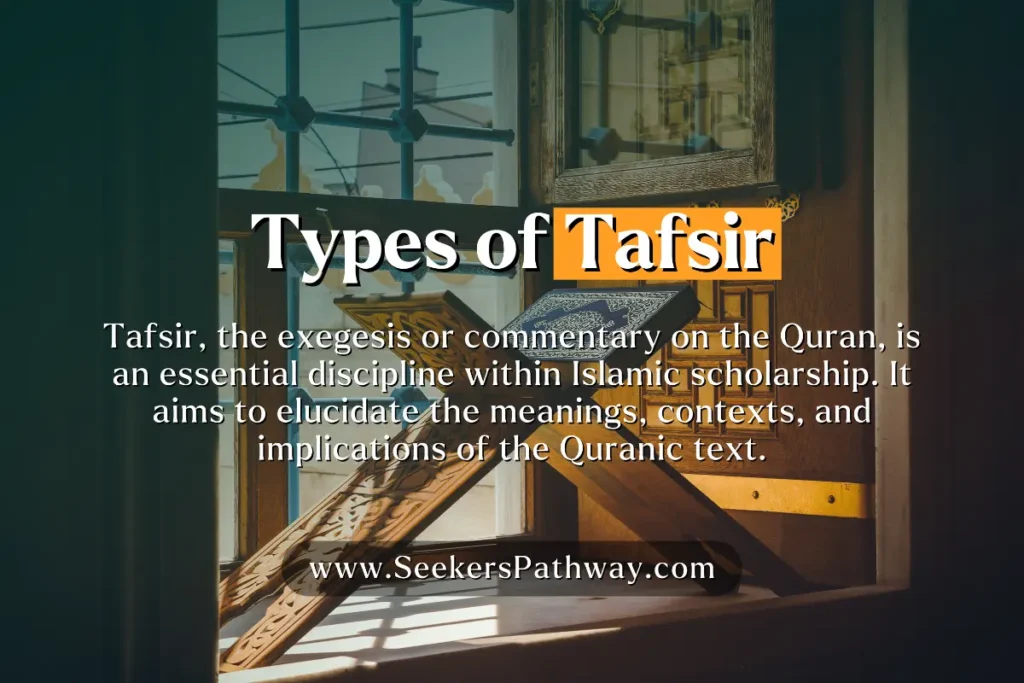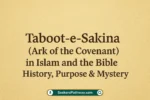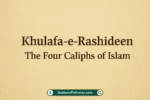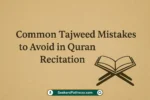Tafsir, the exegesis or commentary on the Quran, is an essential discipline within Islamic scholarship. It aims to elucidate the meanings, contexts, and implications of the Quranic text. Given the complexity of the Quran, various methodologies have emerged to interpret it. This article will explore the different types of tafsir, highlighting their characteristics, methodologies, and significance.
1. Tafsir Bil Ma’thur (Interpretation by Tradition)
Definition
Tafsir Bil Ma’thur relies primarily on the Quran itself, Hadith (sayings of the Prophet Muhammad), and the opinions of the early Muslim community (Sahabah and Tabi’un).
Characteristics
- Source-Based: This type is rooted in authentic sources, emphasizing textual evidence.
- Historical Context: It often includes historical accounts and circumstances surrounding the revelation (Asbab al-Nuzul).
- Authority: Relying on the opinions of the Prophet and his companions provides a strong authoritative basis.
Examples
Prominent scholars such as Ibn Kathir and Al-Tabari are known for their works in Tafsir Bil Ma’thur, providing rich contextual insights drawn from traditional sources.
2. Tafsir Bil Ra’y (Interpretation by Opinion)
Definition
Tafsir Bil Ra’y involves the scholar’s reasoning, personal insights, and linguistic analysis of the Quranic text.
Characteristics
- Analytical: Scholars engage with the text, drawing on linguistic, literary, and logical principles.
- Flexibility: This approach allows for diverse interpretations based on reasoned understanding.
- Innovative: Scholars can present new insights that reflect contemporary issues while remaining rooted in Islamic teachings.
Examples
Al-Raghib al-Isfahani and Al-Fakhr al-Razi exemplify scholars who employed this method, showcasing a blend of reason and textual analysis.
3. Tafsir al-Ma’na (Interpretation of Meaning)
Definition
Tafsir al-Ma’na focuses on the meanings of the words and phrases in the Quran, often emphasizing linguistic and grammatical elements.
Characteristics
- Linguistic Analysis: It examines word roots, syntax, and semantics to derive meaning.
- Clarity Of Expression: Aims to elucidate the meanings in a straightforward manner for better understanding.
Examples
This type is prevalent in works that focus on clarifying Quranic language, such as the writings of Ibn Ashur and Al-Suyuti.

4. Tafsir al-Ishari (Symbolic Interpretation)
Definition
Tafsir al-Ishari is a mystical interpretation that seeks deeper, often esoteric meanings behind the Quranic text.
Characteristics
- Metaphorical: This type often employs allegory and metaphor, emphasizing spiritual and moral lessons.
- Sufi Influence: Frequently found in Sufi literature, it encourages readers to seek inner understanding and divine truths.
Examples
Works by scholars such as Ibn Arabi and Al-Ghazali often exemplify this approach, offering profound spiritual insights.
5. Tafsir al-Nasikh wa al-Mansukh (Interpretation of Abrogation)
Definition
This type examines verses of the Quran that abrogate (nasikh) or are abrogated (mansukh) by others.
Characteristics
- Legal Implications: Essential for understanding changes in rulings and laws within Islamic jurisprudence.
- Contextual Awareness: Requires a thorough understanding of the chronological order of revelation.
Examples
Scholars like Ibn al-Jawzi have addressed this topic, highlighting the dynamic nature of Quranic revelation.
6. Tafsir al-Fiqhi (Legal Interpretation)
Definition
Tafsir al-Fiqhi focuses on deriving legal rulings from the Quranic text.
Characteristics
- Jurisprudential Approach: Scholars analyze verses that pertain to Islamic law (Sharia).
- Case Studies: Often includes practical applications and examples of legal rulings derived from specific verses.
Examples
The works of scholars such as Al-Shafi’i and Ibn Hanbal provide insights into this interpretation, connecting Quranic verses to legal frameworks.
7. Tafsir al-Tafsir (Commentary on Commentaries)
Definition
This type involves commentary on existing tafsir works, aiming to elaborate, critique, or provide alternative interpretations.
Characteristics
- Intertextual Analysis: Engages with previous tafsir to build on or challenge established interpretations.
- Scholarly Discourse: Contributes to the broader conversation within Islamic scholarship.
Examples
Scholars like Al-Maturidi and Al-Ma’mar have produced works that critique or expand on previous tafsir.
Benefits of Enrolling in an Academy for Online Quran Tafseer Course
Enrolling in an Academy for Online Quran Tafseer Course offer flexible, affordable access worldwide with personalized guidance and interactive learning for deeper understanding:
1. Accessibility and Flexibility for International Students
Another very powerful aspect of enrolling in an Online Quran Tafseer Course through an Academy is flexibility. Whether living in the States, the Middle East, Europe, or Asia, any person is able to take part in classes without the need to take location into account. That way, Muslims anywhere on the globe remain part of genuine Islamic information.
2. Individualized Direction and Participatory Learning
Numerous academies provide customized one-against-one sessions with scholars. This allows the student to pose queries, clear misconceptions, and enhance the depth of the meanings of the Quran. Participatory media like live sessions, discussion boards, and groupwork boost the learning.
3. Affordable Islamic Education for All
Unlike traditional centers that require travel and accommodation, on-line academies reduce the cost. By offering cheap bundles of courses, on-line academies bring Islamic learning even within the grasp of resource-poor students.
Final Words
The diversity of tafsir methodologies reflects the richness of Islamic intellectual tradition and the complexity of the Quranic text. Each type of tafsir offers unique insights, enabling the best Quranic scholars and laypeople alike to engage with the Quran in meaningful ways.
Understanding these different approaches not only enriches one’s appreciation of the Quran but also fosters a deeper connection to the Islamic faith and its teachings. As contemporary issues continue to arise, the relevance of these interpretations remains critical, highlighting the timeless nature of the Quran’s guidance.











One Response
Well written